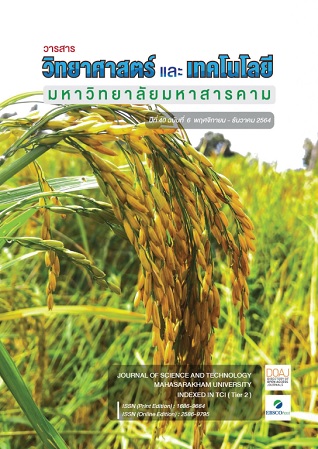Evaluation of greenhouse gas emission from activities of a coastal intensive shrimp farm in Chachoengsao province
Main Article Content
Abstract
This present research study investigated the GHG emission from 3 processes of intensive shrimp farm, namely, pond preparation, culture and harvesting. The activity data such as energy and materials use, waste and water discharge were collected and calculated to greenhouse gas emission. Results show that overall GHG emission for 1 crop was 4.57 kgCO2eq/kg product which the cultural stage was the highest amount of 3.86 kgCO2e/kg. The use of electricity from aeration, auto feeding and lighting in cultural stage was 98% of total GHG emission. If the intermittence aeration was applied and the light bulbs were decreased in number and wattage, the total amount of GHG emission could decrease 9.88%.
Article Details
References
Ahmed, N., & Glaser, M. (2016). Coastal aquaculture, mangrove deforestation and blue carbon emissions: Is REDD+ a solution? Marine Policy, 66, 58–66. https://doi.org/10.1016/j.marpol.2016.01.011
Boyd, C. E. (2015). Calcium, magnesium Use In Aquaculture. Global Aquaculture Advocate, September/October, 28–29.
Boyd, C. E. (2019). Shrimp pond preparation crucial for production, disease prevention. Global Aquaculture Advocate, March 25, 7–11.
Boyd, C. E., & Mcnevin, A. A. (2020). Aerator energy use in shrimp farming and means for improvement. October, 6–29. https://doi.org/10.1111/jwas.12753
Chanda, A., Das, S., Bhattacharyya, S., Das, I., Giri, S., Mukhopadhyay, A., Samanta, S., Dutta, D., Akhand, A., Choudhury, S. B., & Hazra, S. (2019). CO2 fluxes from aquaculture ponds of a tropical wetland: Potential of multiple lime treatment in reduction of CO2 emission. Science of the Total Environment, 655, 1321–1333. https://doi.org/10.1016/j.scitotenv.2018.11.332
Dorber, M., Verones, F., Nakaoka, M., & Sudo, K. (2020). Can we locate shrimp aquaculture areas from space? – A case study for Thailand. Remote Sensing Applications: Society and Environment, 20(September), 100416. https://doi.org/10.1016/j.rsase.2020. 100416
Department of Fisheries (2020). Fisheries statistics of Thailand 2018, Fisheries development and planning division, Ministry of Agriculture and Cooperatives No.10/2020
FAO (1986). Shrimp Culture: Pond Design, Operation and Management: Harvesting and Preservation Available on: http://www.fao.org/3/ac210e/AC210E12.htm#ch12
Haditomo, A. H. C., Wijayanto, D., & Adi, N. S. (2020). Greenhouse gases emission estimation from Indonesia Litopenaeus vannamei shrimp. 13(6), 3778–3788.
Hu, Z., Lee, J. W., Chandran, K., Kim, S., & Khanal, S. K. (2012). Nitrous oxide (N2O) emission from aquaculture: A review. Environmental Science and Technology, 46(12), 6470–6480. https://doi.org/10.1021/es300110x
IPCC. (2006a). N2O Emissions from Managed Soils and CO2 Emissions from Lime and Urea Application. Agriculture, Intergovernmental Panel on Climate Change, 2019 refinement. 1–54. Available online: https://www.ipcc.ch/ report/2019-refinement-to-the-2006-ipcc-guidelines-for-national-greenhouse-gas-inventories/
IPCC.(2006b). Wastewater Treatment and Discharge. IPCC Guidelines for National Greenhouse Gas Inventories Volume 5 Waste, 5, 1–56. Available online: https://www.ipcc-nggip.iges.or.jp/public/2006gl/vol5.html
Kepenyes, J. and Váradi, L. (1984) Chapter 21 Aeration and Oxygenation in Aquaculture (Lecture notes, AdCP Inter-regional Training Course) Budapest: Food and Agriculture Organization of the United Nations Available from: http://www.fao.org/3/x5744e/x5744e0m. htm
Krummenauer, D., Samocha, T., Poersch, L., Lara, G., & Wasielesky, W. (2014). The reuse of water on the culture of pacific white shrimp, litopenaeus vannamei, in BFT system. Journal of the World Aquaculture Society, 45(1), 3–14. https://doi.org/10.1111/jwas.12093
MacLeod, M., Hasan, M., & Robb, D.H.F & Mamun-Ur-Rashid, M. (2019). Quantifying and mitigating greenhouse gas emissions from global aquaculture. FAO Fisheries and Aquaculture Technical Paper No.626.Rome, FAO.
Mohanty RK. Effect of pond aeration on growth and survival of Penaeus monodon Fab. Bangladesh J Fish Res. 2001;5(1):59–65.
Paudel, S. R., Luitel, S., Adhikari, R., Wagle, A., & You, K. (2019). Potential nitrous oxide (N2O) emission from aquaculture in Nepal. International Journal of Environmental Studies, 76(2), 318–328. https://doi.org/10.1080/ 00207233.2018.1560764
Phornprapha, W. (2020). Shrimp Farming in Thailand : A Pathway to Sustainability Pomona Senior Theses. 208. Pomona College. California. USA. https://scholarship.claremont. edu/pomona_theses/208
Putra.A.A., Rudianto and Dewi C.S.U. Analysis Of The Ability Of Mangrove Sequestration And Carbon Stock In Pejarakan Village, Buleleng Regency, Bali. 2019;511–26. Available on: http://journal.ipb.ac.id/index.php/jurnalikt
Rahman, A., Dabrowski, J., McCulloch, J. Dissolved oxygen prediction in prawn ponds from a group of one step predictors: Information Processing in Agriculture 2020;7(2):307–17. Available from: https://doi.org/10.1016/j.inpa.2019.08.002
Robb, David H.F.Michael MacLeod, M. R. H. and D. S. (2017). Greenhouse gas emission from aquaculture A life cycle assessment of three Asian systems. In FAO FISHERIES AND AQUACULTURE TECHNICAL PAPER ISSN 2070-7.
Seeprom, J., Phoochinda, W. (2017). CO2 emission reduction from Vannamei Shrimp Cultures for Moo 3,4,6 in Ongkharak Subdistrict, Bang Pla Ma District, SuphanBuri. 38, 17–33. http://gseda.nida.ac.th/nida/wp-content/ uploads/2017/10/2-เจษฎาพงศ์-บทความส่งคณะ-Conference.pdf
Szuster, B. (2006). Coastal shrimp farming in Thailand: Searching for sustainability. Environment and Livelihoods in Tropical Coastal Zones: Managing Agriculture-Fishery-Aquaculture Conflicts, 86–98. https://doi.org/10.1079/9781845931070.0086
Szuster, B. W., & Molle, F. (2003). Shrimp farming in Thailand’s Chao Phraya river delta: boom, bust and echo. International Water Management Institute, PhD(January), 57. http://www.iwmi.cgiar.org/Assessment/files/word/ProjectDocuments/ChaoPhraya/szuster.pdf
TGO. (2020). Requirements for calculation and report carbon footprint for organization, The Thailand Greenhouse Gas Management Organization.http://thaicarbonlabel.tgo.or.th/admin/uploadfiles/ebook/content/c858f3c01f/index.html
Tien,N.N., Matsuhashi, R., Chau, V.T.T.B.2019 A sustainable energy model for shrimp farms in the Mekong delta. Energy Procedia,157,926–938. https://doi.org/10.1016/j.egypro.2018. 11.259


